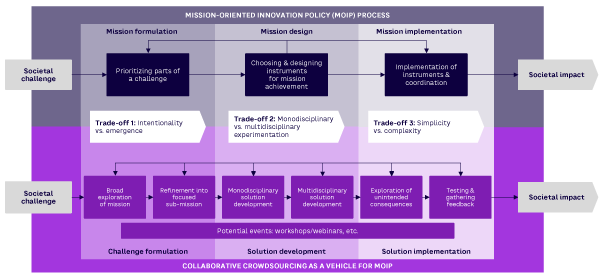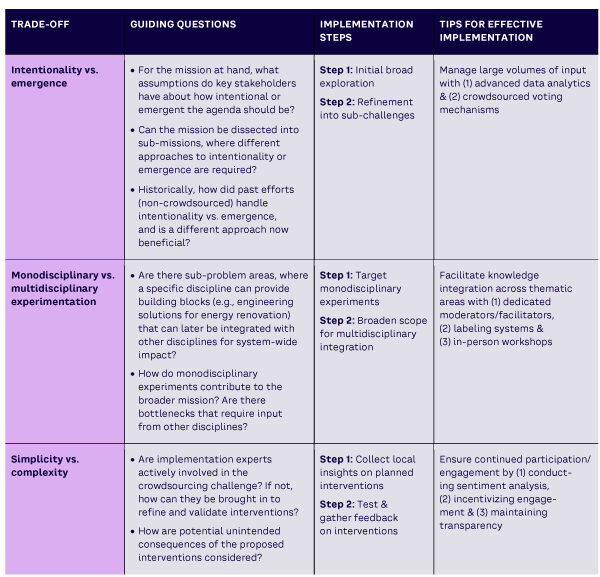AMPLIFY VOL. 37, NO. 10

We face an era where climate change is one of the most pressing challenges for businesses and society. The scale of the crisis — ranging from extreme weather events and rising sea levels to the devastating loss of biodiversity — demands bold, innovative solutions. Yet the pace of change has been alarmingly slow.
Unlike traditional approaches that focus on incremental improvements in specific policy areas, mission-oriented innovation policy (MOIP) takes aim at large, complex societal challenges like climate change by setting bold, overarching goals — often referred to as “missions.”1,2
Although missions hold significant promise for driving radical change across sectors, MOIP orchestrators face a range of trade-offs as they design and implement mission interventions.3 Failing to manage these trade-offs can result in fragmented efforts, misaligned priorities across sectors, and, ultimately, an inability to achieve the transformative impact the mission was designed to deliver.
Collaborative crowdsourcing can help policy orchestrators balance and navigate the trade-offs inherent in managing the missions aimed at climate change mitigation. Once viewed as a tool for generating ideas, crowdsourcing is now recognized as a beneficial method for engaging large, diverse groups of actors to collaboratively tackle systemic problems.4
Unlike tournament-based crowdsourcing, where members of the crowd compete to solve a problem, collaborative crowdsourcing platforms engage the crowd to leverage their collective intelligence, skills, and resources to address the problem.5 By lowering the threshold for participation and offering visibility into a wide range of concerns and suggestions, collaborative crowdsourcing helps orchestrators design more effective governance structures and processes.
In this article, we discuss how MOIP orchestrators can use collaborative crowdsourcing platforms to manage the intricate trade-offs inherent in MOIP: balancing intentionality with emergence in agenda setting, managing monodisciplinary and multidisciplinary experimentation in solution development, and navigating the simplicity and complexity of mission implementation. We also suggest practical implementation steps and actionable tips for policy orchestrators who wish to add crowdsourcing to their innovation toolkit.
Collaborative Crowdsourcing: Vehicle for MOIP
Missions are designed to address complex, multifaceted issues like climate change by cutting across sectors and disciplines to encourage collaboration among government, knowledge institutes, industry, academia, and civil society — each with its own interests, priorities, and agendas.6 Because the problem spans multiple sectors (energy, agriculture, transportation, and more), solutions often have ripple effects, leading to unexpected outcomes. The impacts of problems like climate change are felt across industries, geographies, and ecosystems, making it challenging to pinpoint clear boundaries for action. These interconnected issues and uncertain outcomes make it difficult to predict the full impact of any given intervention.7
As a result, MOIP orchestrators must continually navigate trade-offs.8,9 What is highly desirable in achieving one goal (e.g., aligning action across stakeholder groups) may require compromises on another (e.g., relaxing initial goals to respond to emerging issues), forcing policy orchestrators into a delicate balancing act.
Collaborative crowdsourcing can play an important role here, helping orchestrators: (1) create governance structures that foster collaboration without compromising individual stakeholder needs, (2) facilitate iteration and course correction as knowledge or needs emerge, and (3) employ flexible yet focused strategies to adapt to shifting circumstances while maintaining clear objectives. Figure 1 provides an overview of the trade-offs in the various phases of MOIP and shows how a collaborative crowdsourcing process can be used to manage them.

Trade-Off 1: Balancing Intentionality & Emergence in Agenda-Setting
The first task for MOIP is defining the boundaries and key goals of the mission.10 For example, one of the missions identified in a Dutch MOIP in 2019 was to create a fully CO2-free electricity system by 2050, focusing on solar and wind energy.11
Leaning on incumbents (experienced actors in knowledge and innovation) to draft the missions and programs facilitated the development of specific programs and initiatives aimed at scaling these technologies.12 This intentionality ensured that efforts were aligned, resources were used efficiently, and progress was measurable.
However, after investments in the original mission, incumbents became aware of new technologies and unforeseen challenges. Developments in hydrogen technology, raw materials, and circularity emerged as more important themes than originally thought, and increased tightness in the labor market began posing major challenges for the energy sector.13 Defining the scope of a mission is a complex task that requires an iterative, flexible approach aligned with design thinking, as climate change is not a static issue.
Using crowdsourcing for the agenda-setting phase of MOIP widens the pool of participants to include those that may not fit well in established strategic agendas. For instance, diverse stakeholders (e.g., energy research centers/universities, environmental/sustainability nongovernmental organizations [NGOs], labor unions, and workforce development agencies) can be invited to offer valuable insights about challenges related to raw material shortages or labor constraints before sunken investments have created path dependency for a mission definition.
These contributions can be made visible in real time through the collaborative crowdsourcing platform, signaling to policy orchestrators early on which missions should gain more attention and which require a shift in focus or scope to address emerging concerns. The ability to course-correct a mission’s definition as knowledge or needs emerge helps missions stay on track as the world changes.
Trade-Off 2: Balancing Monodisciplinary & Multidisciplinary Experimentation in Solution Development
The next task is choosing and designing the mission’s innovation instruments.14 These often focus on specific themes or solutions within a single field. Focusing on themes within broader missions enabled the Dutch MOIP to achieve targeted, accelerated innovation.
For example, the Unmanned Surface Vessel project focuses on developing autonomous vessels for offshore wind farms while Recycling for Lead-Free Solar Panels aims to create circular, sustainable solar panels.15
Both solutions fall under the broader mission of achieving a CO2-free electricity system by 2050, with the involvement of select technical organizations: Fugro, which specializes in geotechnical and geospatial services, and Sea-Kit, an expert in autonomous marine vessels, are collaborating on the unmanned surface vessels. TNO, a Dutch organization for applied scientific research, works with solar specialists to develop circular solar panels.
Focused experimentation within their respective fields enables rapid development and testing because stakeholder groups can concentrate on well-defined challenges without extensive coordination across sectors. However, monodisciplinary experimentation for too long will inevitably fall short of achieving systemic change. For instance, the broader mission of transforming the built environment requires that innovations in construction align with goals for energy efficiency, biodiversity, urban sustainability, and more, necessitating collaboration between city planners, environmental agencies, architects, construction companies, and energy suppliers.
Collaborative crowdsourcing lets policy orchestrators transition from monodisciplinary to multidisciplinary solution development by facilitating the integration of diverse perspectives across disciplines in incremental steps. In the case of the Unmanned Surface Vessel project, orchestrators can expand participation beyond a few preselected organizations by asking marine engineers, roboticists, and environmental scientists to contribute ideas or propose design improvements through the crowdsourcing platform.
Each discipline-specific contribution adds to the larger pool of knowledge being shared on the platform, helping stakeholders from different disciplines see the breadth of concerns and issues of the broader mission.
Importantly, crowdsourcing platforms allow participants to “like” or “upvote,” which highlights the most relevant contributions and enables a multi-disciplinary community to surface critical insights that span disciplines.16 For example, if a proposed solution from an architect is seen as highly compatible with energy-efficient designs and sustainable materials, engineers or environmentalists can vote to elevate that solution. Such insights can be fed back into the broader mission, ensuring that targeted innovations contribute to a comprehensive, systemic solution.
By making key insights more visible, orchestrators can guide the conversation toward solutions that best address the problem‘s complexity.
Trade-Off 3: Balancing Simplicity & Complexity in Mission Implementation
During the implementation phase, MOIP orchestrators often prioritize simple, scalable interventions for immediate, measurable results. However, focusing on simple interventions can lead to overlooking systemic complexities. For instance, in the Dutch MOIP’s expansion of offshore wind energy, interventions are designed to deploy wind turbines rapidly and cost-effectively, contributing to immediate energy goals.17 These interventions may overlook second-order effects (e.g., construction noise disrupting marine life) and third-order effects (e.g., declining fish populations impacting local fishing economies).18
Conversely, complex interventions that address these deeper issues can appear overly ambitious or impractical, leading to implementation difficulties. Striking a balance between simplicity and complexity during implementation is crucial to ensure that interventions both deliver quick wins and address broader systemic impacts.
Local stakeholders can visualize the immediate and broader impacts of potential interventions, and crowdsourcing platforms help orchestrators tap into that expertise. For instance, crowdsourcing can involve marine biologists, fishermen, energy companies, environmental NGOs, and coastal communities to provide input on expanding offshore wind farms. Fishermen can describe how construction noise affects fish populations, marine biologists can provide insights into potential impacts on marine biodiversity, and coastal community members can posit changes to tourism or the local economy.
Participants can critically reflect and comment on each other’s contributions to the platform, and this dialogue highlights potential issues from multiple angles. The visibility of contributions to the platform lets orchestrators see the full range of concerns and suggestions, which they can use to iteratively refine interventions. For example, if feedback reveals concerns about construction noise or environmental impacts, orchestrators might implement quieter construction techniques or establish marine conservation areas.
Implementing Collaborative Crowdsourcing to Enable MOIP
This section describes steps for using collaborative crowdsourcing at each phase of the MOIP process (agenda setting, solution development, and mission implementation) and offers practical tips to ensure its effectiveness. Table 1 provides an overview of steps, tips, and key questions to guide MOIP orchestrators in using collaborative crowdsourcing.

Phase 1: Agenda-Setting
Step 1: Initial broad exploration. Start by conducting a broad exploration of the mission to gather perspectives from a wide range of stakeholders. In this phase, crowdsourcing platforms help orchestrators tap into the collective intelligence of industry experts, academics, civil society members, and the public. The goal is to understand the full scope of the mission while identifying emergent themes and sub-problems in real time — things that traditional policy approaches (relying on a narrow set of preselected experts) might miss or reveal too late.
Step 2: Refinement into sub-challenges. The next step is to refine the inputs into sub-challenges. Leverage crowdsourcing platforms to highlight recurring themes, draw attention to the most pressing issues, and focus attention on areas with the highest potential. For example, general feedback on renewable energy can lead to sub-challenges like grid modernization, offshore wind feasibility, or energy-storage innovations. Shifting from broad exploration to sub-challenges enables focused contributions that clarify the sub-missions within the broader mission.
Challenge: Managing large volumes of input. One challenge during this phase is the volume of input. Crowdsourcing gathers feedback from a large, diverse crowd, and orchestrators may find themselves overwhelmed by the number of contributions. To ensure that emergent perspectives don’t overwhelm the core mission and valuable insights aren’t missed, use tools to filter and prioritize relevant contributions:
-
Leverage advanced data analytics. Using AI-driven tools, orchestrators can more effectively manage large volumes of data on a crowdsourcing platform. These tools can automatically cluster similar ideas, track trends, and filter contributions based on predefined criteria such as alignment with mission goals, potential impact, and feasibility. Machine learning algorithms can help orchestrators sift through contributions to detect emergent themes or patterns. Using text mining to analyze contributions can reveal frequently mentioned aspects of the problem or recurring concerns to help orchestrators understand the key issues driving the conversation.
-
Use crowdsourced voting mechanisms. Voting and rating systems enable participants to upvote or rate the most relevant contributions, reducing the burden on orchestrators and allowing the crowd to refine the mission’s direction.
Phase 2: Solution Development
Step 1: Target monodisciplinary experiments. Start by focusing on thematic areas that align with the broader mission, such as the sub-challenges identified in agenda setting. This encourages targeted experimentation on specific challenges, directing participants’ attention to certain issues (e.g., energy efficiency in wind turbines) or key sectors (e.g., the maritime industry). This lets orchestrators extract insights from stakeholders with expertise in these topics, making it easier to generate early-stage experiments that can feed into broader efforts.
Step 2: Broaden scope for multidisciplinary integration. Once initial contributions have been collected from sub-challenges, orchestrators should broaden the scope, gradually introducing multidisciplinary collaboration. This involves integrating perspectives from across contributions and sub-challenges, such as combining technical innovations from engineers with the social or ecological concerns of environmental scientists, economists, and civil society.
Challenge: Facilitating knowledge integration. Solution development relies on how effectively different perspectives and knowledge are integrated. Without clear strategies for integrating knowledge, contributions risk becoming fragmented. Below are some tips for facilitating effective knowledge integration when using crowdsourcing in the solution development phase:
-
Assign dedicated moderators and facilitators. Moderators or facilitators can guide discussions, tag/connect the right experts to specific conversations, and ensure that conversations remain focused and constructive. Moderators can also help bridge knowledge gaps between participants from different disciplines, facilitating knowledge integration.
-
Label and categorize contributions. Use labeling systems to categorize contributions by theme, discipline, or relevance. This makes it easier for participants to navigate and engage with content and for orchestrators to track contributions that cut across multiple sectors or knowledge areas.
-
Host knowledge-integration workshops. By hosting periodic workshops (virtual or in-person), participants from different disciplines can come together to integrate their insights. These workshops can help crystallize ideas and identify synergies that may not emerge in asynchronous online interactions.
Phase 3: Policy Implementation
Step 1: Collect local insights on planned interventions. Actively involve local stakeholders early in the process (community members, regional experts, business owners, and other affected groups). Use the platform to identify potential second-order effects (e.g., environmental impacts like habitat disruption) and third-order effects (e.g., socioeconomic consequences such as changes in local employment patterns) of planned interventions. By collecting and integrating these insights early on, orchestrators can develop a comprehensive understanding of the local context and tailor interventions to address specific needs and concerns.
Step 2: Test and gather feedback on implemented interventions. Once pilot projects are rolled out, orchestrators should use the platform to monitor their outcomes, collecting data on effectiveness, challenges, and unintended consequences.
Challenge: Ensuring participation and engagement. Maintaining active participation and engagement throughout the crowdsourcing process can be challenging, especially as interest wanes. Below are some tips for initiating and sustaining engagement when using crowdsourcing in the policy implementation phase:
-
Conduct sentiment analysis for deeper insights. Orchestrators can use sentiment analysis to analyze the tone and emotional content of comments, helping them gauge the overall sentiment about specific interventions. This deeper layer of understanding helps orchestrators respond more sensitively to the public’s concerns and better adjust policies. Orchestrators can use text mining tools in combination with sentiment analysis to identify patterns, trends, and emerging concerns from contributions shared by the crowd.
-
Incentivize engagement. To encourage participation, create incentives or opportunities in the form of small grants, public acknowledgment, or the opportunity to directly influence policy outcomes.
-
Maintain transparency. Maintain communication channels with participants throughout the process, letting them see how their contributions are being used and encouraging continuous engagement. Be sure to update participants on progress, acknowledge contributions, and celebrate milestones.
Conclusion
Collaborative crowdsourcing has the potential to accelerate MOIP, helping policymakers navigate complex trade-offs in agenda setting, solution development, and implementation. However, there are challenges to this approach, including dealing with large volumes of input, integrating diverse stakeholder perspectives, and maintaining ongoing participation. For crowdsourcing to be effective, it must be thoughtfully designed and actively managed throughout.
Responsible innovation must be a key consideration when using crowdsourcing for MOIP. Ensuring social inclusion is critical — every stakeholder must have the opportunity to contribute, and diverse perspectives should be actively encouraged to avoid marginalizing voices that are often left out. Platform design should adhere to the principle of “digital sufficiency,” ensuring that digital solutions are lean and sustainable.
When used responsibly, crowdsourcing can be a powerful tool for accelerating innovation and advancing environmental goals, making it an ideal solution for organizations and governments committed to the twin transition of digitalization and sustainability.
References
1 Janssen, Matthijs J., et al. “Missions as Boundary Objects for Transformative Change: Understanding Coordination Across Policy, Research, and Stakeholder Communities.” Science and Public Policy, Vol. 50, No. 3, June 2023.
2 Mazzucato, Mariana. “From Market Fixing to Market-Creating: A New Framework for Innovation Policy.” Industry and Innovation, Vol. 23, No. 2, May 2016.
3 Janssen, Matthijs J., et al. “The Promises and Premises of Mission-Oriented Innovation Policy — A Reflection and Ways Forward.” Science and Public Policy, Vol. 48, No. 3, June 2021.
4 Porter, Amanda J., Philipp Tuertscher, and Marleen Huysman. “Saving Our Oceans: Scaling the Impact of Robust Action Through Crowdsourcing.” Journal of Management Studies, 30 May 2019.
5 Porter, Amanda J., Damla Diriker, and Ilse Hellemans. “Crowdsourcing.” In Handbook of Management Communication, edited by François Cooren and Peter Stücheli-Herlach. de Gruyter, 2021.
6 Hekkert, Marko P., et al. “Mission-Oriented Innovation Systems.” Environmental Innovation and Societal Transitions, Vol. 34, March 2020.
7 Ferraro, Fabrizio, Dror Etzion, and Joel Gehman. “Tackling Grand Challenges Pragmatically: Robust Action Revisited.” Organization Studies, Vol. 36, No. 3, February 2015.
8 Janssen et al. (see 1).
9 Janssen et al. (see 3).
10 Goetheer, A., F.A. van der Zee, and M.J.L. de Heide. De Staat van Nederland Innovatieland: Missies en ‘Nieuw’ Missiegedreven Beleid (State of the Netherlands Innovation 2018: Missions and ‘New’ Mission-Driven Policy). TNO, 2018.
11 “Integrale Kennis- en Innovatie Agenda voor Klimaat en Energie 2024–2027” (“IKIA Climate & Energy 2024–2027”). Topsector Energie, November 2023.
12 “Mission Driven Top-Sector Policy.” STIP Compass, 2024.
13 Goetheer et al. (see 10)
14 Topsector Energie (see 11).
15 Topsector Energie (see 11).
16 Majchrzak, Ann, Philip H. Birnbaum, and Samer Faraj. “Transcending Knowledge Differences in Cross-Functional Teams.” Organization Science, January 2012.
17 Topsector Energie (see 11).
18 Bohnsack, René, Christina M. Bidmon, and Jonatan Pinkse. “Sustainability in the Digital Age: Intended and Unintended Consequences of Digital Technologies for Sustainable Development.” Business Strategy and the Environment, Vol. 31, No. 2, February 2022.





